Attached files
| file | filename |
|---|---|
| 8-K - 8-K - Sabra Health Care REIT, Inc. | a8-kbamlpresentationsep2017.htm |
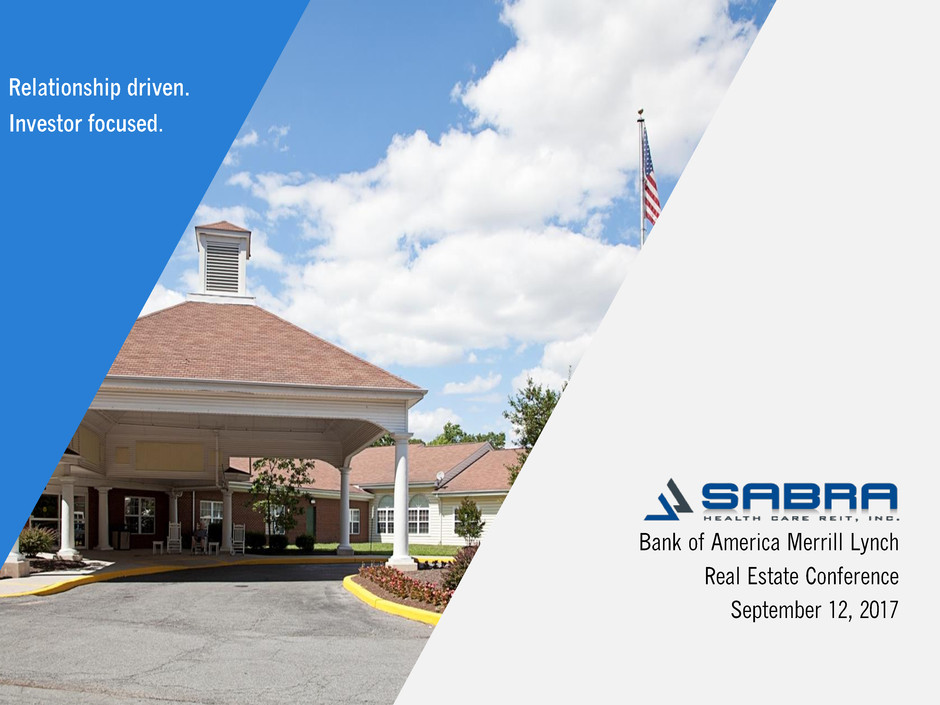
Bank of America Merrill Lynch
Real Estate Conference
September 12, 2017
Relationship driven.
Investor focused.

.
2
Sabra
2Q17
CCP
2Q17
Combined Pro Forma
Sabra (3)
Enterprise Value ($Bn) (1) $2.9 $3.9 $6.8
Equity Value ($Bn) (1) $1.5 $2.1 $3.6
Investments 203 347 550
Top 5 Tenant Concentration 69% 57% 42%
Genesis Concentration 33% 0% 11%
Holiday Concentration 16% 0% 6%
SNF EBITDAR Coverage (4) 1.56x 1.19x 1.47x
SNF Occupancy 88.4% 79.3% 81.1%
Total EBITDAR Coverage (4) 1.44x 1.62x 1.68x
Wtd. Avg. Lease Term 9 years 8 years 9 years
Skilled Mix 43% 39% 40%
MERGER WITH CCP CREATES A PREMIER HEALTHCARE REIT
Transaction improves size, scale, and tenant diversification
(1) Sabra and CCP balance sheets as of 6/30/2017, pro forma for merger; share prices as of 9/6/2017.
(2) Based on Sabra share price of $22.60 as of 9/6/2017 and exchange ratio of 1.123 Sabra shares for each CCP share; Sabra pro forma enterprise value inclusive of debt raised to fund transaction expenses.
(3) Pro forma coverages and tenant concentration adjusted for announced Genesis dispositions and $33.5 million rent reduction.
(4) Coverage metrics presented one quarter in arrears; CCP coverages adjusted to impute a 5% management fee and only includes stabilized properties, consistent with Sabra methodology; coverages exclude tenants with
meaningful credit enhancement through guarantees, which include Avamere, Genesis, Holiday, Senior Care Centers, Signature, and Tenet. The weighted average fixed charge coverage of the guarantors is 1.22x.
(2) (2)
(2) (2)

.
3
14.9%
16.9%
20.6%
21.7% 22.1%
23.6%
0%
5%
10%
15%
20%
25%
0
20,000
40,000
60,000
80,000
100,000
120,000
2015 2020 2030 2040 2050 2060
(00
0s)
65+ % of Total
WHY SKILLED NURSING FACILITIES?
Skilled nursing facilities will remain an integral component of the U.S. continuum of care, leading to attractive
risk adjusted returns for sophisticated and experienced healthcare investors
Compelling
U.S. Aging
Demographics (1)
An aging U.S. population supports healthcare real estate fundamentals
and drives spending in the sector
⁻ The population of people 65+ is anticipated to grow 5x faster than
the rest of the population from 2014 – 2060
⁻ U.S. Census Bureau estimates that by 2030 seniors will account for
one in every five Americans
⁻ Persons aged 65-74 have the highest average annual personal
expenditures
Skilled Nursing
Facility Supply (2)
Steady
Reimbursement
Environment (3)
While industry trends have been muted due to the rapidly evolving
reimbursement environment, the environment has created winners
Government reimbursement rates have increased steadily over time
Nimble operators have always demonstrated the ability to adapt to
reimbursement changes
15,400
15,600
15,800
16,000
16,200
2005 2006 2007 2008 2009 2010 2011 2012 2013 2014 2015
Certified Skilled Nursing Facilities
$0
$100
$200
$300
$400
$500
$600
2000 2001 2002 2003 2004 2005 2006 2007 2008 2009 2010 2011 2012 2013 2014
Avg. SNF Medicaid Rate Per Day Avg. SNF Medicare Rate Per Day
(1) U.S. Census Bureau, Population Division (December 2014 release date).
(2) AHCA data (March 2015).
(3) Eljay LLC, Hansen, Hunter and Company for AHCA and composite of CMS, AHCA, AQNHC, OSCAR, Eljay LLC and Avalere Group Data.
Demographics will drive occupancy in the face of limited /
obsolescent supply
Supply has steadily decreased due to state level certificate-of-need
laws and the changing reimbursement environment
New supply is effectively non-existent

.
4
DEMOGRAPHICS AND SPENDING DRIVE THE OPPORTUNITY
(1) MedPAC.
(2) RBC Capital Markets research.
Skilled Nursing and Transitional Care are shifting towards higher-acuity, short-stay rehab, “step down”
units for hospitals
Comparison of Per Case Rates (1)
Increasing Prevalence of Chronic Disease (2)
Long-Term Care Needs are
Growing
SNFs Remain the Low-Cost
Care Provider vs. Alternative
Services
133
141
149
157 164
171
46%
47%
48% 48%
49% 49%
45%
46%
47%
48%
49%
50%
0
20
40
60
80
100
120
140
160
180
2005A 2010A 2015E 2020E 2025E 2030E
Population with Chronic Conditions (mm) % of US Population with a Chronic Condition
Skilled
Comparison of per Nursing Inpatient Rehab Long-Term
Case Rates Facilities Facilities Acute Care
Tracheotomy with Vent $10,051 $26,051 $115,463
Respiratory with Vent 7,897 26,051 74,689
Joint Replacement 6,165 17,135 67,104
Hip Fracture 10,618 18,487 44,633
Stroke 8,905 34,196 31,496
Average $8,727 $24,384 $66,677

.
5
HIGH QUALITY PORTFOLIO OF PRIMARILY SKILLED NURSING
AND SENIOR HOUSING ASSETS

.
6
STRONG RELATIONSHIPS WITH
EXPERIENCED AND TALENTED OPERATORS
Pro Forma Top 5 Tenant
Concentration(1)
(1) Pro forma tenant concentration, NOI mix and payor mix based on total cash NOI as of Q2 2017, adjusted for announced Genesis dispositions and $33.5 million rent reduction.
Pro Forma NOI Mix (1) Pro Forma Payor Mix (1)
Genesis
11%
Senior
Care
Centers
11%
Avamere
Family of
Companies
7%
Signature
Healthcare
7%
Holiday
6%
Private
Pay
37%
Public Pay
63% Skilled
Nursing
71%
Senior
Housing
17%
Hospital
9%
Interest
Income
3%

.
7
42%
69%69%69%
76%
89%
97%
25%
50%
75%
100%
Pro FormaYE 2016YE 2015YE 2014YE 2013YE 2012YE 2011
11%
32%34%
36%
51%
65%
76%
25%
50%
75%
100%
Pro FormaYE 2016YE 2015YE 2014YE 2013YE 2012YE 2011
CONTINUED MANAGEMENT FOCUS ON OPTIMIZING PORTFOLIO
Genesis Concentration (1) Since the spin-off from Sun Healthcare in 2010,
Sabra will have reduced top 5 tenant concentration
to 42% on a pro forma basis (1)
Combination increases diversification – no tenant
concentration greater than 11.2% (1)
Combined company will continue broad focus on AL,
MC, and IL operators to deliver added growth
Investment Philosophy – acquire portfolios that are
high quality and mispriced by the market
Ability to grow our private-pay exposure through
acquisitions and portfolio management
Strong proprietary development pipeline provides
future deal flow for primarily purpose-built, senior
housing facilities
(1) Tenant concentration from 2011 – 2016 based on GAAP NOI; pro forma tenant concentration based on total cash NOI as of Q2 2017, adjusted for announced Genesis dispositions and
$33.5 million rent reduction.
Improvement in Top 5 Tenant Concentration (1)
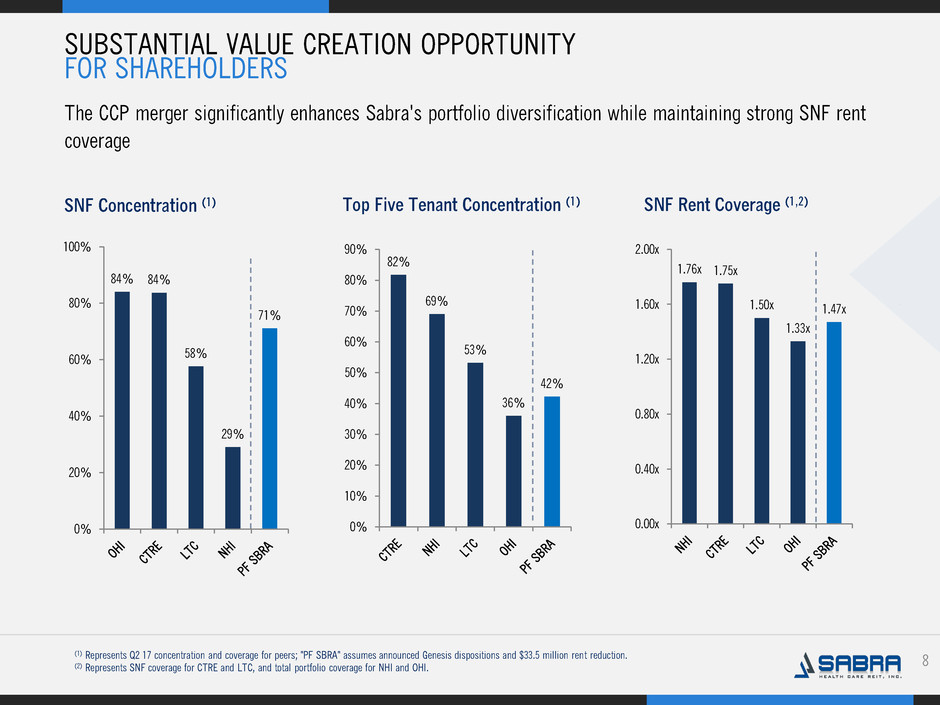
.
8
82%
69%
53%
36%
42%
0%
10%
20%
30%
40%
50%
60%
70%
80%
90%
SUBSTANTIAL VALUE CREATION OPPORTUNITY
FOR SHAREHOLDERS
The CCP merger significantly enhances Sabra's portfolio diversification while maintaining strong SNF rent
coverage
SNF Concentration (1) SNF Rent Coverage (1,2) Top Five Tenant Concentration (1)
(1) Represents Q2 17 concentration and coverage for peers; "PF SBRA" assumes announced Genesis dispositions and $33.5 million rent reduction.
(2) Represents SNF coverage for CTRE and LTC, and total portfolio coverage for NHI and OHI.
84% 84%
58%
29%
71%
0%
20%
40%
60%
80%
100%
1.76x 1.75x
1.50x
1.33x
1.47x
0.00x
0.40x
0.80x
1.20x
1.60x
2.00x

.
9
FOCUSED APPROACH PROVIDES A CONDUIT FOR FUTURE GROWTH
Investment Thesis
Utilize operating and asset management expertise to identify
and capitalize on opportunities
Leverage Sabra's existing and new relationships leading to
significant external growth opportunities
Align with high-quality operators to assist in their strategic
goals
Focus on operators with local and regional expertise to
capitalize on favorable demographics
Pursue strategic development opportunities with attractive
risk-adjusted returns
Smaller initial investments in purpose-built facility
development projects lower Sabra’s development risk
Create a diversified portfolio that is well-positioned for the
future of healthcare delivery
Focus on investments where we identify off-market price
dislocation
Thinking Outside The Box
Operating expertise and deal structure flexibility drive competitive advantage
Traditional REIT
structures
- Sale/leasebacks
- Mortgage debt
Smaller
investments with
options to
purchase
Managed
properties
Preferred equity &
mezzanine debt
Development
agreements
Forward purchase
commitments
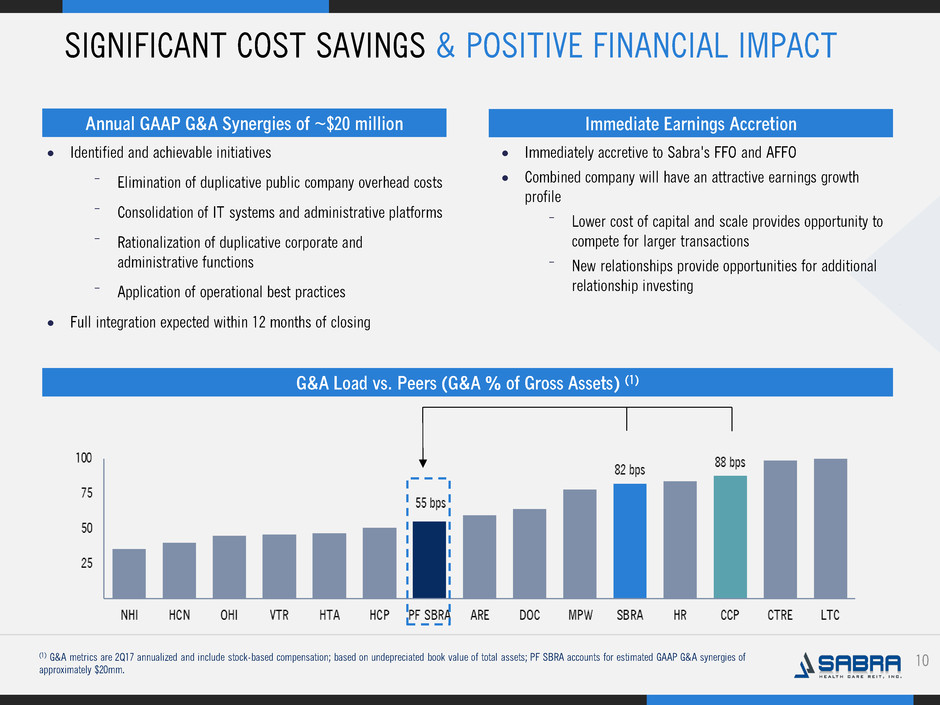
.
10
SIGNIFICANT COST SAVINGS & POSITIVE FINANCIAL IMPACT
(1) G&A metrics are 2Q17 annualized and include stock-based compensation; based on undepreciated book value of total assets; PF SBRA accounts for estimated GAAP G&A synergies of
approximately $20mm.
G&A Load vs. Peers (G&A % of Gross Assets) (1)
Annual GAAP G&A Synergies of ~$20 million
Identified and achievable initiatives
⁻ Elimination of duplicative public company overhead costs
⁻ Consolidation of IT systems and administrative platforms
⁻ Rationalization of duplicative corporate and
administrative functions
⁻ Application of operational best practices
Full integration expected within 12 months of closing
Immediate Earnings Accretion
Immediately accretive to Sabra's FFO and AFFO
Combined company will have an attractive earnings growth
profile
⁻ Lower cost of capital and scale provides opportunity to
compete for larger transactions
⁻ New relationships provide opportunities for additional
relationship investing
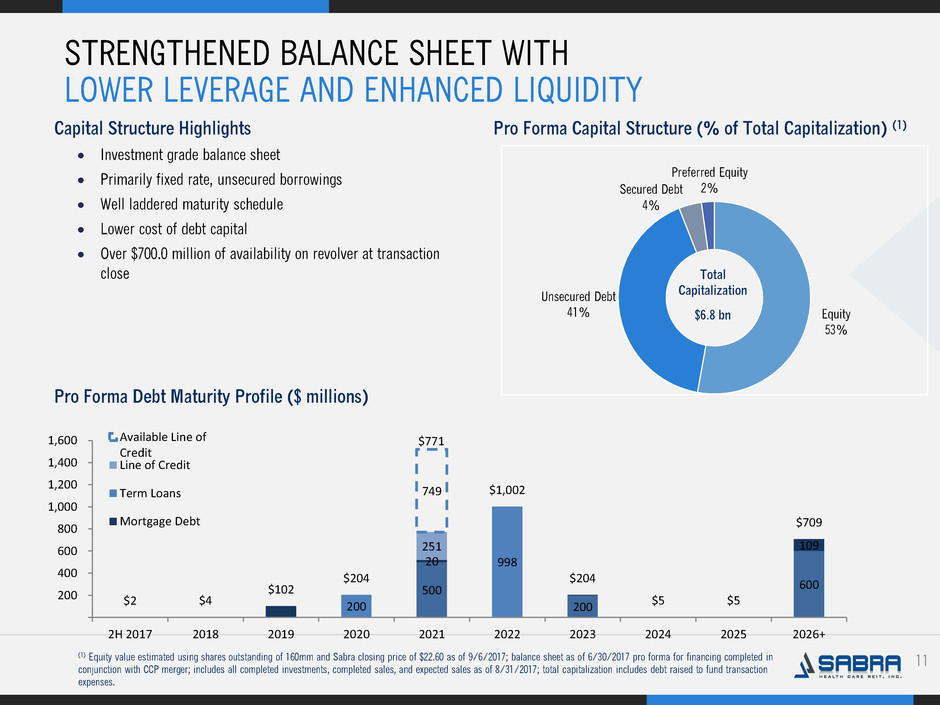
.
11
Equity
53%
Unsecured Debt
41%
Secured Debt
4%
Preferred Equity
2%
STRENGTHENED BALANCE SHEET WITH
LOWER LEVERAGE AND ENHANCED LIQUIDITY
Capital Structure Highlights Pro Forma Capital Structure (% of Total Capitalization) (1)
Investment grade balance sheet
Primarily fixed rate, unsecured borrowings
Well laddered maturity schedule
Lower cost of debt capital
Over $700.0 million of availability on revolver at transaction
close
Pro Forma Debt Maturity Profile ($ millions)
Total
Capitalization
$6.8 bn
(1) Equity value estimated using shares outstanding of 160mm and Sabra closing price of $22.60 as of 9/6/2017; balance sheet as of 6/30/2017 pro forma for financing completed in
conjunction with CCP merger; includes all completed investments, completed sales, and expected sales as of 8/31/2017; total capitalization includes debt raised to fund transaction
expenses.
500
200
600
20
109
200
998
251
749
$2 $4
$102
$204
$771
$1,002
$204
$5 $5
$709
200
400
600
800
1,000
1,200
1,400
1,600
2H 2017 2018 2019 2020 2021 2022 2023 2024 2025 2026+
Available Line of
Credit
Line of Credit
Term Loans
Mortgage Debt

.
12
STRONG CREDIT METRICS
(1) Based on forecasted pro forma LTM adjusted EBITDA, which includes GAAP G&A synergies, and balance sheet as of 9/30/2017; includes all completed investments, completed sales, and expected sales as of 9/30/2017.
Sabra 2Q17 PF Sabra (1)
Net Debt to Adjusted EBITDA 5.4x 5.1x
Debt as a % of Gross Asset Value 43% 45%
Interest Coverage Ratio 3.9x 4.5x
Fixed Charge Coverage Ratio 3.2x 4.1x
Secured Debt to Gross Asset Value 6% 4%
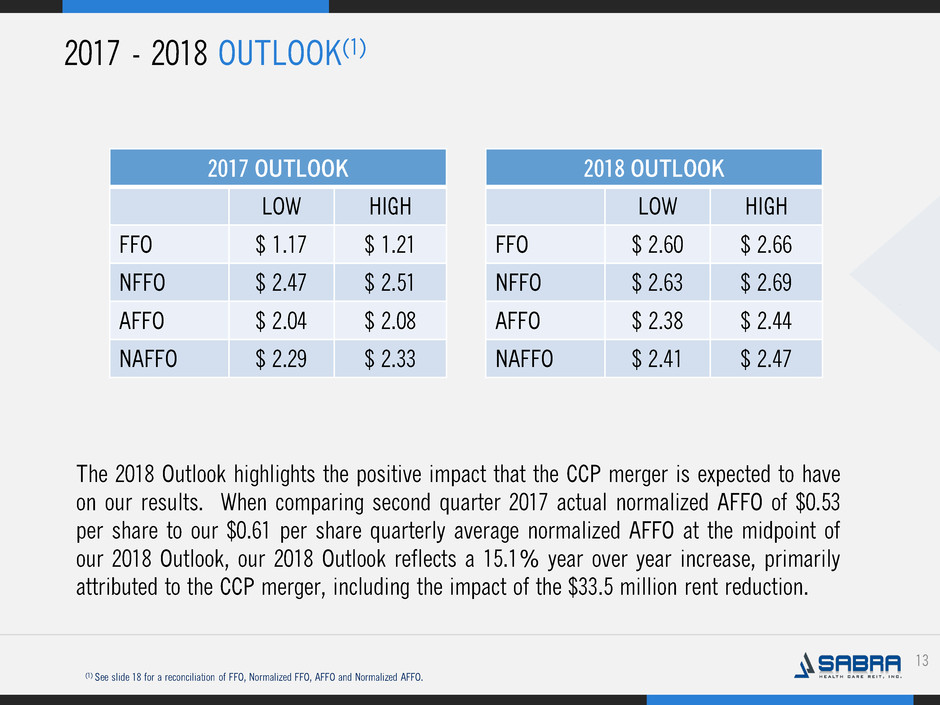
.
13
2017 - 2018 OUTLOOK(1)
2017 OUTLOOK
LOW HIGH
FFO $ 1.17 $ 1.21
NFFO $ 2.47 $ 2.51
AFFO $ 2.04 $ 2.08
NAFFO $ 2.29 $ 2.33
2018 OUTLOOK
LOW HIGH
FFO $ 2.60 $ 2.66
NFFO $ 2.63 $ 2.69
AFFO $ 2.38 $ 2.44
NAFFO $ 2.41 $ 2.47
The 2018 Outlook highlights the positive impact that the CCP merger is expected to have
on our results. When comparing second quarter 2017 actual normalized AFFO of $0.53
per share to our $0.61 per share quarterly average normalized AFFO at the midpoint of
our 2018 Outlook, our 2018 Outlook reflects a 15.1% year over year increase, primarily
attributed to the CCP merger, including the impact of the $33.5 million rent reduction.
(1) See slide 18 for a reconciliation of FFO, Normalized FFO, AFFO and Normalized AFFO.
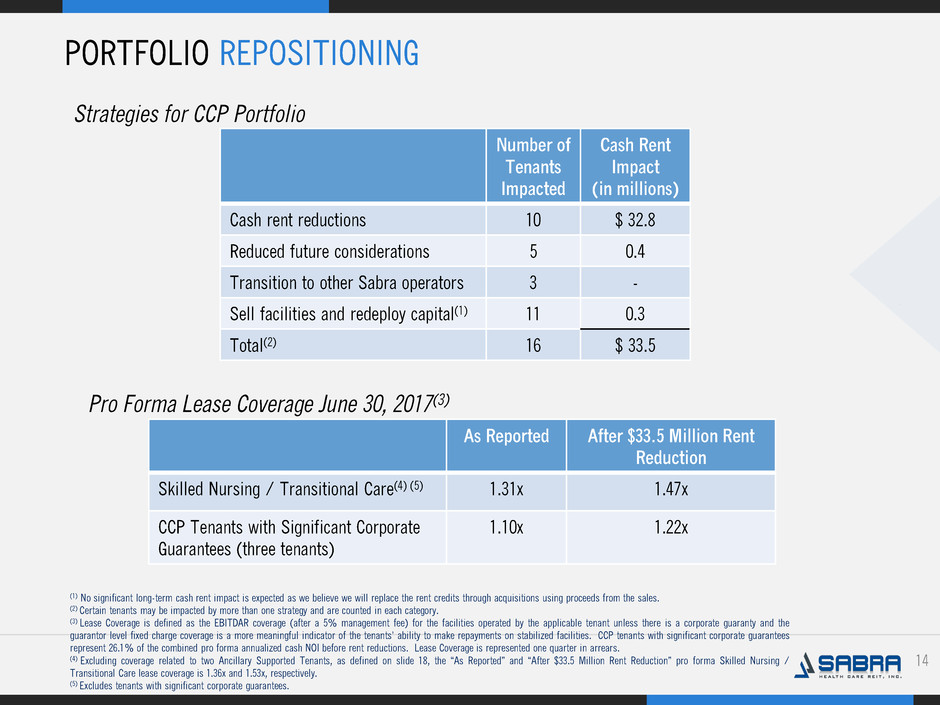
.
14
PORTFOLIO REPOSITIONING
(1) No significant long-term cash rent impact is expected as we believe we will replace the rent credits through acquisitions using proceeds from the sales.
(2) Certain tenants may be impacted by more than one strategy and are counted in each category.
(3) Lease Coverage is defined as the EBITDAR coverage (after a 5% management fee) for the facilities operated by the applicable tenant unless there is a corporate guaranty and the
guarantor level fixed charge coverage is a more meaningful indicator of the tenants’ ability to make repayments on stabilized facilities. CCP tenants with significant corporate guarantees
represent 26.1% of the combined pro forma annualized cash NOI before rent reductions. Lease Coverage is represented one quarter in arrears.
(4) Excluding coverage related to two Ancillary Supported Tenants, as defined on slide 18, the “As Reported” and “After $33.5 Million Rent Reduction” pro forma Skilled Nursing /
Transitional Care lease coverage is 1.36x and 1.53x, respectively.
(5) Excludes tenants with significant corporate guarantees.
Number of
Tenants
Impacted
Cash Rent
Impact
(in millions)
Cash rent reductions 10 $ 32.8
Reduced future considerations 5 0.4
Transition to other Sabra operators 3 -
Sell facilities and redeploy capital(1) 11 0.3
Total(2) 16 $ 33.5
As Reported After $33.5 Million Rent
Reduction
Skilled Nursing / Transitional Care(4) (5) 1.31x 1.47x
CCP Tenants with Significant Corporate
Guarantees (three tenants)
1.10x 1.22x
Pro Forma Lease Coverage June 30, 2017(3)
Strategies for CCP Portfolio

.
15
FUTURE ROADMAP
Integrate the acquired corporate infrastructure into Sabra's platform
Execute on synergies
Target achieving investment grade rating at transaction close
Expand and close on the value-adding pipeline of opportunities
Optimize portfolio with select investments and SNF dispositions
STATUS
In process
In process
In process
In process

.
16
PROVEN SENIOR MANAGEMENT TEAM
TRACK RECORD OF DRIVING RETURNS
Rick Matros
Chairman, President &
CEO
Rick Matros has served as Sabra’s President and Chief Executive Officer and as a Director since May 2010, and as Chairman of the
Board since November 2010. He was also Chairman of the Board of Directors and Chief Executive Officer of Sun Healthcare Group, Inc.
from 2001 to 2010
Served as Chief Executive Officer and President of Bright Now! Dental from 1998 to 2000 and as a Director from 1998 until its sale in
December 2010
From 1998 until the sale of its operations in 2006, was a member of the management committee of CareMeridian, LLC
From 1994 to 1997, served Regency Health Services, Inc. as Chief Executive Officer, President, Director and Chief Operating Officer
Currently serves on the Executive Board for RFE Investment Partners and is the Executive Producer of Sabra Films, LLC
Harold W. Andrews Jr.
CFO and EVP
Harold W. Andrews, Jr. has served as Sabra’s Executive Vice President, Chief Financial Officer and Secretary since November 2010
Member of the management committee of Journey Health Properties, LLC and Journey Lane 5, LLC, two real estate holding entities
From 1997 to May 2008, was a Partner and Chief Financial Officer of CareMeridian, LLC
From 1996 to 1997, served as the Vice President of Finance for Regency Health Services, Inc., a provider of post-acute care services
Spent 10 years in public accounting at Arthur Andersen LLP, including time as Senior Manager for healthcare and real estate companies
CPA and Member of the AICPA and Financial Executives International
Talya Nevo-Hacohen
Chief Investment Officer
and EVP
Talya Nevo-Hacohen serves as Sabra's Executive Vice President, Chief Investment Officer and Treasurer
From 2006 to 2008 and from February 2009 to November 2010, served as an advisor to private real estate developers and operators
regarding property acquisitions and dispositions, corporate capitalization, and equity and debt capital raising
From August 2008 to February 2009, was a Managing Director with Cerberus Real Estate Capital Management, LLC
From 2003 to 2006, was Senior Vice President—Capital Markets and Treasurer for HCP, Inc.
From 1993 to 2003, worked for Goldman, Sachs & Co. where she was a Vice President in the investment banking and finance, operations
and administration divisions
Prior to her affiliation with Goldman Sachs, she practiced architecture and was associated with several architectural firms in New York
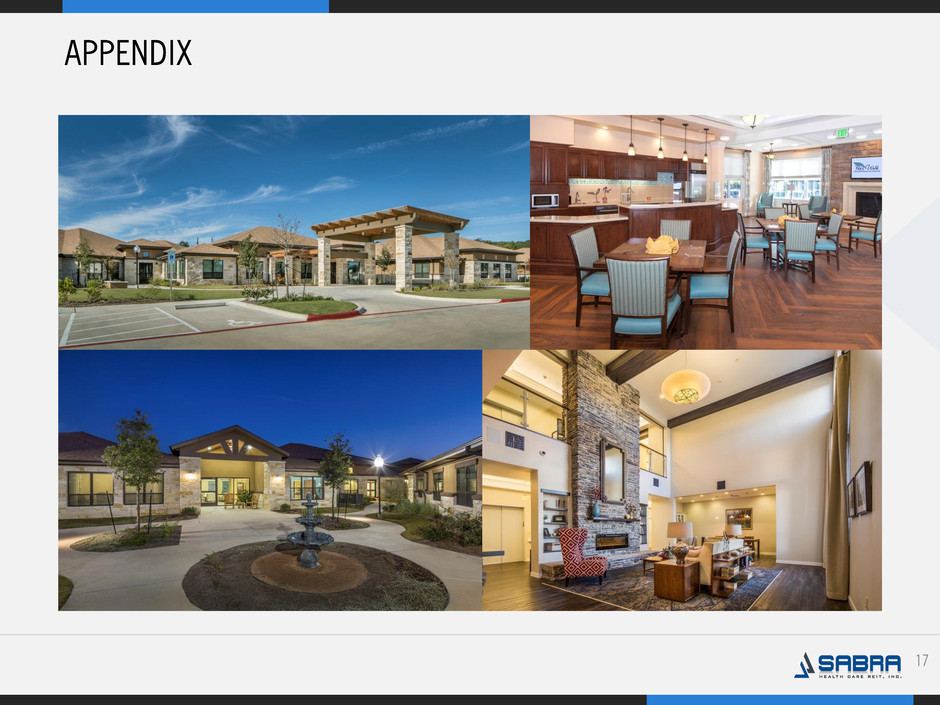
.
17
APPENDIX
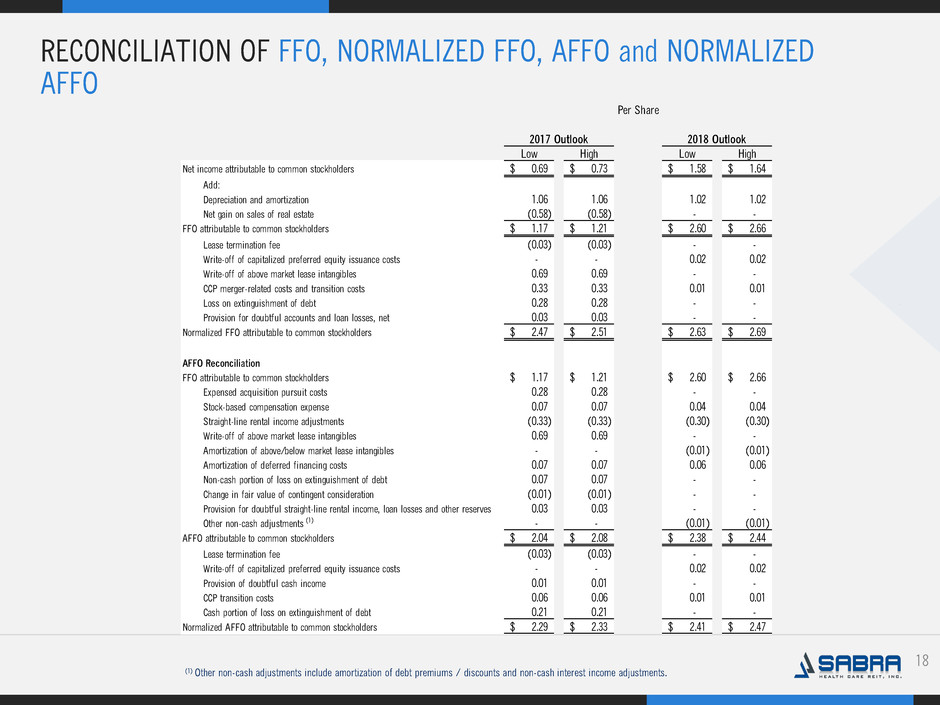
.
18
RECONCILIATION OF FFO, NORMALIZED FFO, AFFO and NORMALIZED
AFFO
Option One
Option
Three
Ma
(1) Other non-cash adjustments include amortization of debt premiums / discounts and non-cash interest income adjustments.
Low High Low High
Net income attributable to common stockholders 0.69$ 0.73$ 1.58$ 1.64$
Add:
Depreciation and amortization 1.06 1.06 1.02 1.02
Net gain on sales of real estate (0.58) (0.58) - -
FFO attributable to common stockholders 1.17$ 1.21$ 2.60$ 2.66$
Lease termination fee (0.03) (0.03) - -
Write-off of capitalized preferred equity issuance costs - - 0.02 0.02
Write-off of above market lease intangibles 0.69 0.69 - -
CCP merger-related costs and transition costs 0.33 0.33 0.01 0.01
Loss on extinguishment of debt 0.28 0.28 - -
Provision for doubtful accounts and loan losses, net 0.03 0.03 - -
Normalized FFO attributable to common stockholders 2.47$ 2.51$ 2.63$ 2.69$
AFFO Reconciliation
FFO attributable to common stockholders 1.17$ 1.21$ 2.60$ 2.66$
Expensed acquisition pursuit costs 0.28 0.28 - -
Stock-based compensation expense 0.07 0.07 0.04 0.04
Straight-line rental income adjustments (0.33) (0.33) (0.30) (0.30)
Write-off of above market lease intangibles 0.69 0.69 - -
Amortization of above/below market lease intangibles - - (0.01) (0.01)
Amortization of deferred financing costs 0.07 0.07 0.06 0.06
Non-cash portion of loss on extinguishment of debt 0.07 0.07 - -
Change in fair value of contingent consideration (0.01) (0.01) - -
Provision for doubtful straight-line rental income, loan losses and other reserves 0.03 0.03 - -
Other non-cash adjustments (1) - - (0.01) (0.01)
AFFO attributable to common stockholders 2.04$ 2.08$ 2.38$ 2.44$
Lease termination fee (0.03) (0.03) - -
Write-off of capitalized preferred equity issuance costs - - 0.02 0.02
Provision of doubtful cash income 0.01 0.01 - -
CCP transition costs 0.06 0.06 0.01 0.01
Cash portion of loss on extinguishment of debt 0.21 0.21 - -
Normalized AFFO attributable to common stockholders 2.29$ 2.33$ 2.41$ 2.47$
2017 Outlook 2018 Outlook
Per Share
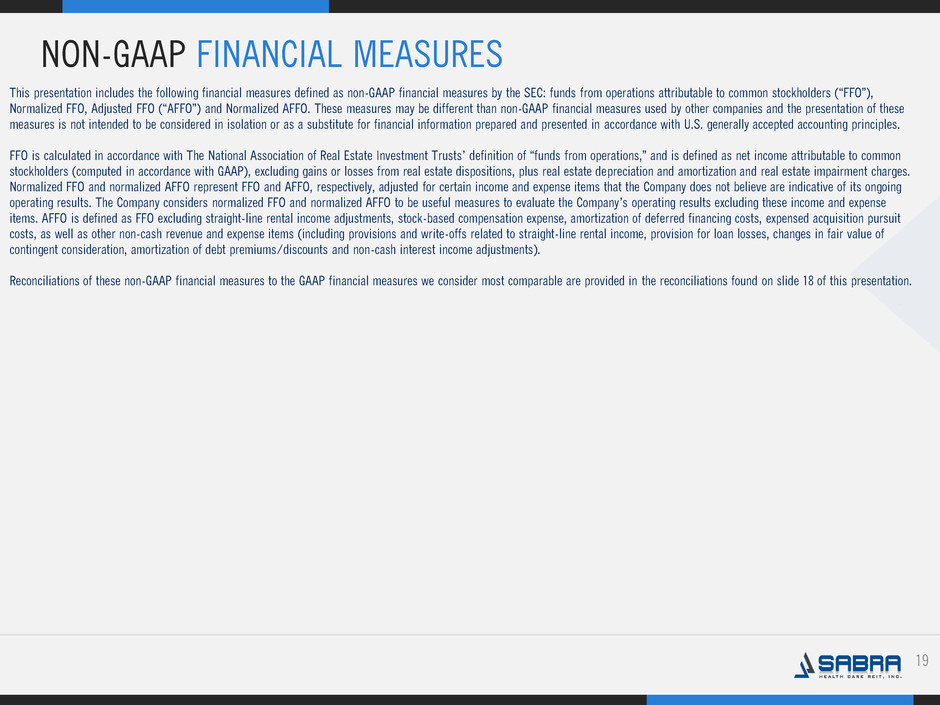
.
19
NON-GAAP FINANCIAL MEASURES
Option One
Option
Three
Ma
This presentation includes the following financial measures defined as non-GAAP financial measures by the SEC: funds from operations attributable to common stockholders (“FFO”),
Normalized FFO, Adjusted FFO (“AFFO”) and Normalized AFFO. These measures may be different than non-GAAP financial measures used by other companies and the presentation of these
measures is not intended to be considered in isolation or as a substitute for financial information prepared and presented in accordance with U.S. generally accepted accounting principles.
FFO is calculated in accordance with The National Association of Real Estate Investment Trusts’ definition of “funds from operations,” and is defined as net income attributable to common
stockholders (computed in accordance with GAAP), excluding gains or losses from real estate dispositions, plus real estate depreciation and amortization and real estate impairment charges.
Normalized FFO and normalized AFFO represent FFO and AFFO, respectively, adjusted for certain income and expense items that the Company does not believe are indicative of its ongoing
operating results. The Company considers normalized FFO and normalized AFFO to be useful measures to evaluate the Company’s operating results excluding these income and expense
items. AFFO is defined as FFO excluding straight-line rental income adjustments, stock-based compensation expense, amortization of deferred financing costs, expensed acquisition pursuit
costs, as well as other non-cash revenue and expense items (including provisions and write-offs related to straight-line rental income, provision for loan losses, changes in fair value of
contingent consideration, amortization of debt premiums/discounts and non-cash interest income adjustments).
Reconciliations of these non-GAAP financial measures to the GAAP financial measures we consider most comparable are provided in the reconciliations found on slide 18 of this presentation.

.
20
FORWARD LOOKING STATEMENTS
Option One
Option
Three
Ma
This presentation contains “forward-looking” statements that may be identified, without limitation, by the use of “expects,” “believes,” “intends,” “should” or comparable terms or
the negative thereof. Forward-looking statements in this presentation include, but are not limited to, statements about our merger with CCP, the expected impact of the merger on
our financial results, our ability to achieve the synergies and other benefits of the merger with CCP, and our strategic and operational plans, as well as all statements regarding
expected future financial position, results of operations, cash flows, liquidity, financing plans, business strategy, the expected amounts and timing of dividends, projected expenses
and capital expenditures, competitive position, growth opportunities and potential investments, plans and objectives for future operations and compliance with and changes in
governmental regulations. These statements are made as of the date hereof and are subject to known and unknown risks, uncertainties, assumptions and other factors—many of
which are out of the Company’s control and difficult to forecast—that could cause actual results to differ materially from those set forth in or implied by our forward-looking
statements. These risks and uncertainties include but are not limited to: the potential adverse effect on tenant and vendor relationships, operating results and business generally
resulting from the CCP merger; changes in healthcare regulation and political or economic conditions; the anticipated benefits of the merger with CCP may not be realized; the
anticipated and unanticipated costs, fees, expenses and liabilities related to the merger; the outcome of any legal proceedings related to the merger; our dependence on the
operating success of our tenants; the significant amount of and our ability to service our indebtedness; covenants in our debt agreements that may restrict our ability to pay
dividends, make investments, incur additional indebtedness and refinance indebtedness on favorable terms; increases in market interest rates; changes in foreign currency
exchange rates; our ability to raise capital through equity and debt financings; the impact of required regulatory approvals of transfers of healthcare properties; the relatively illiquid
nature of real estate investments; competitive conditions in our industry; the loss of key management personnel or other employees; the impact of litigation and rising insurance
costs on the business of our tenants; the effect of our tenants declaring bankruptcy or becoming insolvent; uninsured or underinsured losses affecting our properties and the
possibility of environmental compliance costs and liabilities; the ownership limits and anti-takeover defenses in our governing documents and Maryland law, which may restrict
change of control or business combination opportunities; the impact of a failure or security breach of information technology in our operations; our ability to find replacement
tenants and the impact of unforeseen costs in acquiring new properties; our ability to maintain our status as a REIT; and compliance with REIT requirements and certain tax and tax
regulatory matters related to our status as a REIT.
Additional information concerning risks and uncertainties that could affect our business can be found in our filings with the Securities and Exchange Commission (the “SEC”),
including Item 1A of our Annual Report on Form 10-K for the year ended December 31, 2016 and Item 1A of our Quarterly Report on Form 10-Q for the quarter ended March 31,
2017. Forward-looking statements made in this presentation are not guarantees of future performance, events or results, and you should not place undue reliance on these forward-
looking statements, which speak only as of the date hereof. The Company assumes no, and hereby disclaims any, obligation to update any of the foregoing or any other forward-
looking statements as a result of new information or new or future developments, except as otherwise required by law.
TENANT AND BORROWER INFORMATION
This presentation includes information (e.g., EBITDAR coverage, EBITDARM coverage and occupancy percentage) regarding certain of our tenants that lease properties from us and
our borrowers, most of which are not subject to SEC reporting requirements. Genesis is subject to the reporting requirements of the SEC and is required to file with the SEC annual
reports containing audited financial information and quarterly reports containing unaudited financial information. The information related to our tenants and borrowers that is
provided in this presentation has been provided by such tenants and borrowers. We have not independently verified this information. We have no reason to believe that such
information is inaccurate in any material respect. We are providing this data for informational purposes only. Genesis’s filings with the SEC can be found at www.sec.gov.

.
21
DEFINITIONS
Option One
Option
Three
Ma
Ancillary Supported Tenants. A tenant, or one of its affiliates, owns an ancillary business that depends on providing services to the residents of the properties leased by the affiliated operating
company (Sabra’s tenant) for a meaningful part of the ancillary business’s profitability.
Cash NOI. The Company considers cash net operating income (“NOI”) an important supplemental measure because it allows investors, analysts and our management to evaluate the operating
performance of our investments. We define cash NOI as total revenues less operating expenses and non-cash revenues.
EBITDA. Earnings before interest, taxes, depreciation and amortization ("EBITDA") excluding the impact of stock-based compensation expense under the Company's long-term equity award program,
asset specific loan loss reserves, significant out of period revenues and expenses, and further adjusted to give effect to acquisitions and dispositions as though such acquisitions and dispositions
occurred at the beginning of the period ("Adjusted EBITDA") is an important non-GAAP supplemental measure of operating performance.
EBITDAR Coverage. Represents the ratio of EBITDAR to contractual rent for owned facilities (excluding Managed Properties). EBITDAR Coverage is a supplemental measure of an operator/tenant's
ability to meet their cash rent and other obligations to the Company. However, its usefulness is limited by, among other things, the same factors that limit the usefulness of EBITDAR.
EBITDARM Coverage. Represents the ratio of EBITDARM to contractual rent for owned facilities (excluding Managed Properties). EBITDARM coverage is a supplemental measure of a property's
ability to generate cash flows for the operator/tenant (not the Company) to meet the operator's/tenant's related cash rent and other obligations to the Company. However, its usefulness is limited by,
among other things, the same factors that limit the usefulness of EBITDARM.
Fixed Charge Coverage Ratio. EBITDAR (including adjustments for one-time and pro forma items) for the period indicated for all operations of any entities that guarantee the tenants' lease
obligations to the Company divided by the same period cash rent expense, interest expense and mandatory principal payments for operations of any entity that guarantees the tenants' lease obligation
to the Company. Fixed Charge Coverage is a supplemental measure of a guarantor's ability to meet the operator/tenant's cash rent and other obligations to the Company should the operator/tenant be
unable to do so itself. However, its usefulness is limited by, among other things, the same factors that limit the usefulness of EBITDAR.
Occupancy Percentage. Occupancy Percentage represents the facilities’ average operating occupancy for the period indicated. The percentages are calculated by dividing the actual census from the
period presented by the available beds/units for the same period. Occupancy for independent living facilities can be greater than 100% for a given period as multiple residents could occupy a single
unit.
Senior Housing. Senior housing facilities include independent living, assisted living, continuing care retirement community and memory care facilities.
Skilled Mix is defined as the total Medicare and non-Medicaid managed care patient revenue at Skilled Nursing/Transitional Care facilities divided by the total revenues at Skilled
Nursing/Transitional Care facilities for the period indicated.
Skilled Nursing/Transitional Care. Skilled nursing/transitional care facilities include skilled nursing, transitional care, multi-license designation and mental health facilities.
Stabilized Facility. At the time of acquisition, the Company classifies each facility as either stabilized or pre-stabilized. In addition, the Company may classify a facility as pre-stabilized after
acquisition. Circumstances that could result in a facility being classified as prestabilized include newly completed developments, facilities undergoing major renovations or additions, facilities being
repositioned or transitioned to new operators, and significant transitions within the tenants’ business model. Such facilities will be reclassified to stabilized upon maintaining consistent occupancy
(85% for Skilled Nursing/Transitional Care and 90% for Senior Housing Facilities) but in no event beyond 24 months after the date of classification as pre-stabilized. Stabilized Facilities exclude (i)
Managed Properties, (ii) facilities held for sale, (iii) facilities being positioned to be sold, (iv) facilities being transitioned from being leased by the Company to being operated by the Company, and (v)
facilities acquired during the three months preceding the period presented.
Note: All facility financial performance data were derived solely from information provided by operators/tenants and relevant guarantors without independent verification by the Company.
